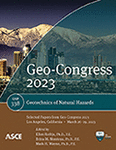A Machine Learning-Based Approach for Predicting Structural Settlement on Layered Liquefiable Soils Improved with Densification
Publication: Geo-Congress 2023
ABSTRACT
In this paper, we propose a machine learning-based approach for predicting foundation settlement on liquefiable soils improved through ground densification. The model considers variations in the properties of the soil profile, foundation, 3D structure, mitigation design (in terms of densified depth and width), and ground motion. A numerical data set from 770, 3D, fully coupled, effective-stress, finite element analyses was developed initially with a statistically determined range of input parameters (through quasi-Monte Carlo sampling). The numerical models were themselves calibrated and validated with centrifuge model studies. Subsequently, the numerical database and an additional 15 centrifuge experiments were used to train a gradient boosting model (tree-based, supervised, machine learning method, GB) for predicting foundation’s settlement. In general, the data-driven GB model could better predict settlement compared to the classical regression model (by about 14%). This is because the non-functional form model could better capture the nonlinear trends in permanent foundation settlement as observed in the numerical and experimental database. However, when evaluating a very limited existing field case history database in the literature, the data-driven GB model only slightly improved the settlement predictions compared to the regression model. This is because the GB model cannot take the impact of model features on foundation settlement in a continuous manner (due to the inherent shortcoming of a decision-tree framework in GB), leading to a dramatic increase in model uncertainty when the input parameters are outside the ranges considered in the database. The insight from the presented GB model aims to guide the development of future data-driven predictive models for a more reliable estimation of engineering demand parameters related to soil–foundation–structure systems.
Get full access to this article
View all available purchase options and get full access to this chapter.
REFERENCES
Bray, J., M. Cubrinovski, J. Zupan, and M. Taylor. 2014. “Liquefaction effects on buildings in the central business district of Christchurch.” Earthquake Spectra 30 (1): 85–109. https://doi.org/10.1193/022113EQS043M.
Bray, J. D., and J. Macedo. 2017. “6th Ishihara lecture: Simplified procedure for estimating liquefaction-induced building settlement.” Soil Dynamics and Earthquake Engineering, 102, 215–231.
Bullock, Z., S. Dashti, A. Liel, K. Porter, Z. Karimi, and B. Bradley. 2017. “Ground‐motion prediction equations for Arias intensity, cumulative absolute velocity, and peak incremental ground velocity for rock sites in different tectonic environments.” Bulletin of the Seismological Society of America, 107(5), 2293–2309.
Bullock, Z., Z. Karimi, S. Dashti, K. Porter, A. B. Liel, and K. W. Franke. 2019. “A physics-informed semi-empirical probabilistic model for the settlement of shallow-founded structures on liquefiable ground.” Géotechnique, 69(5), 406–419.
Bullock, Z., S. Dashti, A. Liel, andK. Porter. 2021. Physics-Informed Probabilistic Models for Peak Pore Pressure and Shear Strain in Layered, Liquefiable Deposits. Géotechnique, pp.1–40.
Cho, Y., F. Khosravikia, and E. M. Rathje. 2022. A comparison of artificial neural network and classical regression models for earthquake-induced slope displacements. Soil Dynamics and Earthquake Engineering, 152, p.107024.
Elgamal, A., Z. Yang, and E. Parra. 2002. “Computational modeling of cyclic mobility and post-liquefaction site response.” Soil Dyn. Earthquake Eng. 22 (4): 259–271. https://doi.org/10.1016/S0267-7261(02)00022-2.
Hausler, E. A. 2002. Influence of ground improvement on settlement and liquefaction: a study based on field case history evidence and dynamic geotechnical centrifuge tests. Ph.D. dissertation. Berkeley, University of California.
Hashash, Y. M. A., M. I. Musgrove, J. A. Harmon, O. Ilhan, D. R. Groholski, C. A. Phillips, and D. Park. 2017. DEEPSOIL 7.0, User Manual.
Hwang, Y. W., Z. Bullock, S. Dashti, and A. Liel. 2022. A Probabilistic Predictive Model for Foundation Settlement on Liquefiable Soils Improved with Ground Densification. Journal of Geotechnical and Geoenvironmental Engineering, 148(5), p.04022017.
Ishihara, K., and Y. Koga. 1981. “Case studies of liquefaction in the 1964 Niigata earthquake.” Soils and foundations, 21(3), 35–52.
Kawakami, F., and A. Asada. 1966. “Damage to the ground and earth structures by the Niigata earthquake of June 16, 1964.” Soils and Foundations, 6(1), 14–30.
Kuhlemeyer, R. L., and J. Lysmer. 1973. Finite element method accuracy for wave propagation problems. Journal of the Soil Mechanics and Foundations Division, 99(5), pp.421–427.
Liu, L., and R. Dobry. 1997. “Seismic response of shallow foundation on liquefiable sand.” Journal of geotechnical and geoenvironmental engineering 123.6: 557–567.
Olarte, J., S. Dashti, and A. Liel. 2018. “Can ground densification improve seismic performance of the soil-foundation-structure system on liquefiable soils.” Earth. Eng. Struct. Dyn. : 1–19. https://doi:10.1002/eqe.3012.
Tiznado, J. C., S. Dashti, and C. Ledezma. 2021. “Probabilistic Predictive Model for Liquefaction Triggering in Layered Sites Improved with Dense Granular Columns.” Journal of Geotechnical and Geoenvironmental Engineering, 147(10), 04021100.
Watanabe, T. 1966. “Damage to oil refinery plants and a building on compacted ground by the Niigata earthquake and their restoration.” Soils and foundations, 6(2), 86–99.
Wang, M. X., D. Huang, G. Wang, and D. Q. Li. 2020. SS-XGBoost: a machine learning framework for predicting newmark sliding displacements of slopes. Journal of Geotechnical and Geoenvironmental Engineering, 146(9), p.04020074.
Information & Authors
Information
Published In
History
Published online: Mar 23, 2023
ASCE Technical Topics:
- Artificial intelligence and machine learning
- Centrifuge models
- Computer programming
- Computing in civil engineering
- Databases
- Engineering fundamentals
- Foundation settlement
- Foundations
- Geomechanics
- Geotechnical engineering
- Information Technology (IT)
- Machine foundations
- Mathematics
- Models (by type)
- Numerical models
- Parameters (statistics)
- Soil dynamics
- Soil mechanics
- Soil settlement
- Statistics
Authors
Metrics & Citations
Metrics
Citations
Download citation
If you have the appropriate software installed, you can download article citation data to the citation manager of your choice. Simply select your manager software from the list below and click Download.
